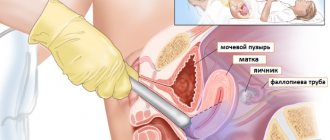A smear examination for oncocytology allows you to actively identify various diseases of the cervix. It is prescribed for specific indications and for preventive purposes for the early detection of malignant neoplasms and precancerous conditions. Thanks to the introduction of this method into practice, the percentage of advanced forms of cancer has significantly decreased.
- Indications for oncocytology of the cervix
- Preparing for the study
- How are smears taken for oncocytology?
- How is cervical oncocytology done?
- What does oncocytology of the cervix show and how to interpret the analysis
- Smear for oncocytology: studies during pregnancy
- Oncocytology for older women
Indications for oncocytology of the cervix
Since this is a screening test, a smear for oncocytology is performed on all women of reproductive age at least once every 3 years. If there is a gynecological pathology or a family history of cancer, the examination is carried out more often (the specific timing is set by the doctor). It is recommended to take oncocytology in the following cases:
- at the stage of preparation for pregnancy;
- if suspicious areas are detected on the cervical part of the uterus during a gynecological examination (hyperemic, bleeding, etc.);
- in the presence of genital warts, HPV infection, inflammatory processes and other background and precancerous diseases;
- for monitoring during and after specific treatment of cervical diseases;
- to clarify the diagnosis (if the level of oncological markers increases, if pathological changes are detected during ultrasound examination, etc.);
- if a woman has a high risk of developing cervical cancer (blood relatives had malignant tumors of the reproductive system, have chronic HPV infection, HIV, regular exposure to carcinogenic factors);
- if there are complaints (discharge from the genital tract that is atypical for age, contact bleeding, nagging pain in the lower abdomen, etc.);
- if a woman gave birth several times in a row, there were early (before 18 years of age) or complicated births;
- during the onset of menopause, especially when taking MHT (menopausal hormone therapy);
- with frequent changes of sexual partners;
- before installing an IUD (intrauterine device).
A smear for oncocytology is regularly performed for women with precancerous diseases (polyps, leukoplakia, erythroplakia, dysplasia).
Cervical cancer: a preventable disease
Cervical cancer is merciless. More than 500,000 new cases of cervical cancer are registered annually around the world, and about 53% of women die. In our country, this cancer kills 21 women every day. We know a lot about this disease, because the cervix is an organ that is quite accessible to examination. Why are we still diagnosing things too late?
Cervical cancer
A disease with a well-studied and proven cause. In 2008, Harald zur Hausen won the Nobel Prize for proving the connection between HPV infection (human papillomavirus) and the development of cervical cancer. Back in 1983, he managed to discover the most aggressive type of virus - HPV-16. Over 34 years of research, which involved more than 10,000 patients, it was proven that 95% of cervical cancer cases are associated with one of the types - HPV-16 or HPV-18.
As always, a new idea captured hearts and minds. Thousands of doctors then rushed to look for HPV in millions of women, followed by monstrous attempts to get rid of the pathogen at any cost. In my memory, dozens of drugs came onto the market with the promise of “cure HPV forever.” Enthusiastic reviews gave way to bewilderment and disappointment. Each subsequent medicine became more expensive than the previous one, each was accompanied by evidence of effectiveness in the form of studies of varying degrees of homegrown. I can safely say that we have definitely achieved only one effect - we have created HPV hysteria in the space around us.
“HPV cure” has become so popular that I am no longer surprised by claims that someone was cured of HPV with cow pats or Allokin-alpha.
Time for the big scare
Now it is obvious to most specialists: HPV is highly contagious; most sexually active women with more than one partner encounter HPV at least once in their lives. HPV is an epitheliotropic virus. It lives in the thickness of the epithelial layer on the cervix, vaginal walls or on the skin of the external genitalia. Moreover, we often see the place of its “registration” through a colposcope, and the results of vital activity in the form of atypical cells end up in cytological smears.
Women who have been diagnosed with HPV often cry in my office. Their last hope is for a “magic pill” that will cure the evil virus. In fact, there is no reason for tears yet.
In most cases, HPV infection does not require any treatment at all, because the virus is spontaneously eliminated - it leaves the body on its own without any treatment along with the exfoliating cells of the stratified squamous epithelium.
If the HPV test is positive, but there are no colposcopic and cytological signs of damage, no treatment is required.
The senseless and merciless use of immunotherapy drugs for the latent form of HPV infection causes damage not only to the wallet, but also, possibly, to the body. Admittedly, our actions in relation to the immune system are suspiciously reminiscent of the pirouettes of a bull in a china shop. We can’t even proudly boast: “I cured Ivanova’s latent form of HPV!” Because it is impossible to prove why the virus left the body. Either he did it voluntarily, or he somehow got bored with our medicinal shamanism.
The younger the woman, the higher the likelihood of spontaneous elimination. Most experts consider it inappropriate to routinely test sexually active women under 25 years of age for HPV. However, these patients with latent forms of HPV require careful monitoring. We will have to repeat the examination once or twice a year to make sure that HPV has left the body. The average time for self-elimination of the virus is 1.5 years.
If the same type of HPV was detected three times over the course of 1.5–2 years, we can talk about persistence. Persistence can also be suspected if the viral load is high in women over 30 years of age. This in no way means that the patient has cervical cancer or its prestages, but, of course, indicates a significant risk and requires the same thing - careful monitoring.
Persistence of HPV without colposcopic and cytological signs of damage is not a reason for treatment.
And then, like Khoja Nasreddin: either the donkey dies or the sultan dies. Either HPV will leave the body, or we will still “catch” changes in cytology or colposcopy.
Why get tested?
Firstly, in order to identify a favorable group - women without HPV. They can be invited for screening less often (provided they have a monogamous sexual relationship); the risk of developing cervical cancer in this group is minimal.
Already in 2009, it was possible to prove that HPV-negative CIN (pre-stage cervical cancer) is impossible. If the results of a cytological examination indicate a precancerous condition of the cervix, and tests for HPV are negative, then someone is mistaken.
I often offer the mantra to my patients: “No HPV, no cervical cancer.” However, it must be remembered that the human factor has not been canceled. Errors when taking material for research, errors during storage and transportation, and errors during research can create a picture of false well-being. HPV testing is not the gold standard. Everything should be assessed in combination with cytology and colposcopy.
Who really needs HPV testing:
- patients with unclear results of cytological smears;
- after surgical treatment of precancerous diseases of the cervix - CIN;
- as a regular screening for patients over 25 years of age;
- with questionable results of colposcopy.
Cervical cancer develops very slowly. From the moment HPV enters the body to the development of cancer, years, and sometimes even decades, pass. At first, the activity of the virus is almost invisible, but as soon as it is integrated into the genome of the cells, we will see characteristic changes in cytological smears. Koilocytes ("empty" cells typical of HPV infection) and dikaryosis (various disorders in the cell nucleus, multinucleated cells) appear. This stage can last from 3 to 20 months.
Under unfavorable conditions, real cancer cells appear on the lower layers of the epithelial layer, where the most active cell division occurs. This is CIN I (mild dysplasia or grade 1 cervical intraepithelial neoplasia). As scary as it sounds, CIN I is not cancer; it develops many years before actual cancer.
In stage CIN I, the disease is reversible.
For young women and/or women planning pregnancy, we have the right to continue observation for 1.5 to 2 years. If the process is not going to regress, treatment is carried out. Drug therapy is ineffective and can be used either as an auxiliary method or not at all. And treatment is the complete removal of the lesion: excision (removal of the affected area) or conization (removal of a cone-shaped fragment of the cervix).
On average, CIN I turns into CIN II–III in 3–5 years (of course, the process will be much faster with concomitant HIV infection, chlamydia or gonorrhea). But there is still nothing irreparable at these stages. If we “caught” the patient at stages CIN II – CIN III, then wide excision of the affected areas is performed: excision or conization of the cervix.
A young woman with CIN I, having read horror stories on the Internet, sobs bitterly:
- Why are you crying so much? — I read that I will have cancer! I will die! - But you are already here. We would be worthless on a market day if we did not know how to identify and treat this stage. After all, this is exactly why you came to the gynecologist - so that you don’t miss CIN. We didn't miss it. Now let’s carefully remove everything and continue to observe. - Will I be able to give birth? - Necessarily. - When will it be possible to get pregnant? - You can start 6 weeks after surgery.
Wide excision of the affected areas with a loop of a radio wave apparatus is a simple procedure. We mostly do this on an outpatient basis under local anesthesia. The entire removed area is sent for histological examination.
If it's so simple, why are women still dying?
This is a cruel and valid question. Cervical cancer is always someone's fault. Although, of course, if a woman did not go to the gynecologist’s office for 10 years, only doing an ultrasound from time to time, anything could be grown.
Olga was 44 years old. I leafed through her outpatient card: gynecologist, gynecologist, gynecologist... Over the past 10 years, she gave birth to three children and had 4 abortions. There is not a single cytological smear in the card. In the mirrors - advanced cervical cancer, symptomatic treatment.
Elena, 32 years old. She gave birth to 2 children with an interval of 2 years, came for an appointment 4 months after the second birth. Cytological smears were taken twice during pregnancies, but probably very gently for fear of spotting. In the mirrors - cervical cancer, stage IIb - we will be treated.
Marina, 38 years old, cook. He undergoes regular medical examinations and shows his health certificate. In the mirrors - advanced cervical cancer, stage III, we will be treated, but the prognosis is very doubtful. I doubt she was examined in mirrors at all. Perhaps they took smears for gonorrhea and trichomoniasis without looking. The most annoying thing is that Olga was sure that everything was fine with her, since she was regularly examined.
Cervical cancer is a disease of the young. The peak incidence in our country occurs at the age of 30–35 years. The cervix is an easily accessible object for research, which makes each case of advanced cancer even worse. The disease is easily preventable by catching it at the CIN stage. And the woman will get married, and give birth to a child or three, and live a long and colorful life.
My youngest patient with invasive cervical cancer was 23 years old. A young man brought her by the hand to be examined for infection. The young man was bothered by the unpleasant smell of his beloved’s discharge. Wertheim's operation, radiation therapy, then relapse, chemotherapy. She died 2 years after diagnosis.
It is impossible not to take into account the human factor... Someone did not come to the appointment, someone did not take a cytological smear or collected the material well enough, someone did not examine single atypical cells due to pronounced inflammatory changes. There are many reasons for late diagnosis. It takes years from the introduction of HPV into the genome of epithelial cells to the onset of cancer, but invasive cancer grows and progresses very quickly.
Today, a new cervical screening strategy is being implemented everywhere in the Russian Federation - the use of liquid cytology with HPV testing. This significantly increases the chances of early diagnosis of cancer. It is this problem that gynecologists should deal with, and not “cauterizing erosions” and a merciless battle with HPV.
Let's set goals correctly. We strive to catch cancer in its pre-stages and neutralize it. “Cauterizing” everything that turns red does not help the diagnosis; on the contrary, it creates serious difficulties, masking a slowly smoldering process.
Hunting for CIN
The implementation of a simple algorithm guarantees timely diagnosis of changes in the cervix.
- Smears for oncocytology must be done for all women who are sexually active. You can do it annually, but not less than every 3–5 years. Women over 25 years of age should undergo HPV testing along with cytology.
- A “bad” cytology smear and/or detected HPV requires mandatory colposcopy. An unclear red spot on the cervix, even with “good” cytological smears and the absence of HPV, requires mandatory colposcopy.
- Abnormal colposcopy results require taking a biopsy from all suspicious areas, or, which is more correct and cheaper, performing a wide biopsy of the cervix.
After treatment for CIN, continued follow-up for at least 5 years is strongly recommended. Anything can happen—the disease can recur. If you don't lose sight of it for a couple of years, you can notice a relapse in time and prevent the development of invasive cancer.
Oksana Bogdashevskaya
Photos 1- thinkstockphotos.com, 2-5 - provided by the author
Preparing for the study
To get a reliable result when taking oncocytology, you must adhere to the following rules:
- on the eve and on the day of the study, do not douche, do not use sanitary tampons, vaginal suppositories, tablets, creams, lubricants and other means;
- 2-3 days before taking a smear, refrain from sexual intercourse;
- you cannot take the test during menstruation, a few days before and after it;
- 2 hours before the test do not urinate;
- Extended colposcopy cannot be done earlier than 48 hours before oncocytology.
It is also advisable to exclude any unfavorable factors (stress, hypothermia, etc.) on the day of the examination. If a woman is taking any medications, the doctor should be informed about this in advance. In case of an acute inflammatory process in the vagina, a smear for oncocytology is not taken. The test is performed only after anti-inflammatory therapy.
How are smears taken for oncocytology?
The study is carried out during a routine appointment with a gynecologist. The woman sits in a gynecological chair. The doctor inserts a special speculum into the external genital tract to gain access to the cervical part of the uterus. The biomaterial is taken separately from the vaginal area of the cervix and the cervical canal (inner part) using special medical instruments (brush, spatula).
As a rule, the patient does not feel pain during the taking of smears. Hypersensitive individuals may experience short-term minor discomfort. As a rule, an analysis for oncocytology is carried out in conjunction with a bacteriological study of vaginal microflora and HPV testing. Often, smear collection is combined with other procedures (follow-up colposcopy, etc.).
The resulting material is sent to the laboratory for study. Its fixation occurs using one of the standard methods used in oncocytology:
- the biomaterial is applied to sterile glass, then fixed with a special solution and stained, followed by examination under a microscope (PAP test, Papanicolaou method);
- a removable brush with epithelial particles is placed in a special tightly closing flask, the study is carried out using special equipment (liquid oncocytology).
On average, taking a smear takes 10-15 minutes. Glasses and flasks must be marked. They indicate the study number, patient data, sampling site (ecto-, endocervix).
What is an oncocytology test?
The most dangerous condition that a cytology smear can reveal is, of course, cervical cancer. But with the help of this analysis, it is possible to diagnose precancerous conditions such as erythroplakia and leukoplakia, as well as cervical polyps and cervical dysplasia.
The results of the finished analysis provide for the following stages of change:
- Oncocytology test was negative, no cellular changes were detected.
- changes in the analysis indicate the presence of an inflammatory process.
- The analysis revealed single atypical cells.
- the smear contains cells with signs of malignancy.
- the smear revealed a large number of atypical cells with signs of malignancy.
If the result of an oncocytology test is questionable, the patient must undergo colposcopy - a gynecological examination, which consists of examining the cervix using a special apparatus. Further examination methods are biopsy followed by histology (detailed study of tissue), ultrasound, and MRI.
How is cervical oncocytology done?
The resulting smears are studied in the laboratory. For Pap staining, the evaluation is performed by staff using a microscopic examination. If there are a lot of cells and they are layered on top of each other, it is not always possible to draw correct conclusions, so laboratory doctors recommend repeating the test.
Liquid oncocytology is more informative, since biological samples are more “clean” (there is no accumulation of cells, blood elements, etc.). They are prepared and processed by a special computerized system. If necessary, biological material can be subjected to additional diagnostic methods, for example, immunohistochemical analysis. Therefore, it is liquid oncocytology that is considered the standard in the diagnosis of cervical diseases, in particular cancer.
What does oncocytology of the cervix show and how to interpret the analysis
The doctor evaluates the result of the smear for oncocytology. Approximately 10% of tests taken using the Papanicolaou method for one reason or another show an unreliable picture (there were errors during the collection of biomaterial, incorrect transportation, etc.). Good quality samples are graded according to the international Bethesda scale. The latter is not only descriptive, but also determines further medical tactics.
There are the following interpretations of a smear for oncocytology:
- NILM: no pathological changes, no treatment required.
- LSIL: the smear revealed mild lesions of the squamous epithelium within the mucous layer, which corresponds to a low risk of developing malignant tumors of the cervix, a characteristic picture for HPV infection and GIN-I dysplasia are determined.
- HSIL: significant changes in the epithelial layer are diagnosed, classified as GIN-II and GIN-III dysplasia, that is, atypical cells are detected, which corresponds to a high risk of cervical cancer, therefore further examination and treatment are required.
- GIS: a smear confirms the presence of invasive cancer, the patient is sent for consultation to a gynecological oncologist at a specialized institution.
The Bethesda system also uses the following terms: ASC-US (there are atypical cells, but a specific answer cannot be given due to the unsatisfactory quality of the biological material) and ASC-H (ambiguous result requiring repeated analysis).
Decoding a smear for oncocytology according to Papanicolaou includes five gradations:
- Stage I - cytological picture is within normal limits;
- Stage II - there are inflammatory changes, further examination and treatment are carried out;
- Stage III - a smear for oncocytology shows the presence of a small number of locally changed cells with disturbances in the structure of the nucleus and cytoplasm, which requires a comprehensive examination by the attending physician and additional diagnostic tests;
- Stage IV - malignant degeneration of cellular structures is diagnosed, which indicates severe dysplasia or the development of an oncological process in the cervix, the patient is sent to undergo additional clarifying procedures to confirm the diagnosis (colposcopy, collection of biological material for histological examination, etc.) with subsequent appointment adequate treatment.
- Stage V - a smear for oncocytology confirms the presence of a large number of altered epithelial cells, which largely indicates the presence of an oncological process in the cervix.
One should take into account the fact that each of the ten tests determines the norm. However, doctors advise taking smears at least once every three years, even in absolutely healthy women.
Oncocytology for older women
Despite the fact that in women with the onset of menopause, the risk of developing cervical diseases decreases, a smear for oncocytology is a mandatory test when visiting a gynecologist’s office. If the patient has undergone this study over the past three years, and no pathological changes in the structure of epithelial cells were detected, then in the postmenopausal period it is recommended to repeat the test once every two years.
Provided that the smear was performed irregularly, or there were deviations in its interpretation, doctors advise doing the analysis every year. If the results are negative within three years, repeated studies are not carried out.
Book a consultation 24 hours a day
+7+7+78
How often should women have a smear for cytology?
Every year the number of obligate and facultative precancerous diseases, as well as malignant neoplasms of the uterus and cervix, increases. This is facilitated by untimely diagnosis of pathological processes in the urogenital tract, and sometimes by the complete absence of preventive measures by the gynecologist. Women under 50 years of age are most susceptible to the disease. This is due both to actively functioning endocrine glands and to a less serious approach to one’s health.
What is a cytology smear?
A cytology smear from the cervical canal is a microscopic research method, which is one of the leading diagnostic methods for identifying inflammatory processes and malignant neoplasms. This smear is based on the identification of atypical or destruction of normal epithelial cells. After interpreting the smear results, the doctor prescribes additional tests, if necessary, such as colposcopy with biopsy, tests for tumor markers, or a repeat smear test.
In a normal smear there are no atypia of epithelial cells; all cells are approximately the same size, with the same nuclei and regular shape.
Frequency of smear cytology.
This type of examination is carried out by all sexually active women of any age and from 21 years of age, regardless of whether they are sexually active. From 21 to 49 years of age, the frequency of taking a smear is 1 time in 3 years, and after 50 - 1 time in 5 years
Women over 65, in the absence of a history of gynecological pathologies and with an adequate smear for oncocytology over the past 10 years, do not need to undergo a repeat smear. This is due to the fact that if all of the above points are present, the risk of morbidity is reduced to zero.
In some cases, a smear is done more often, once a year, or once every 6 months, these situations include:
- Taking oral contraceptives
- Promiscuity
- History of any type of human papillomavirus
- Before any gynecological interventions: placement of an intrauterine device, abortion.
- Pregnancy planning.
- Previous supravaginal amputation, as well as hysterectomy for uterine or cervical cancer.
- Suspicion of cervical cancer.
Despite the fact that there is a certain time frame for this study, any woman, if desired, can do this analysis at any time. It is necessary to take a smear on the 5th day of the cycle; 1-2 days before taking a smear, refrain from sexual intercourse.










